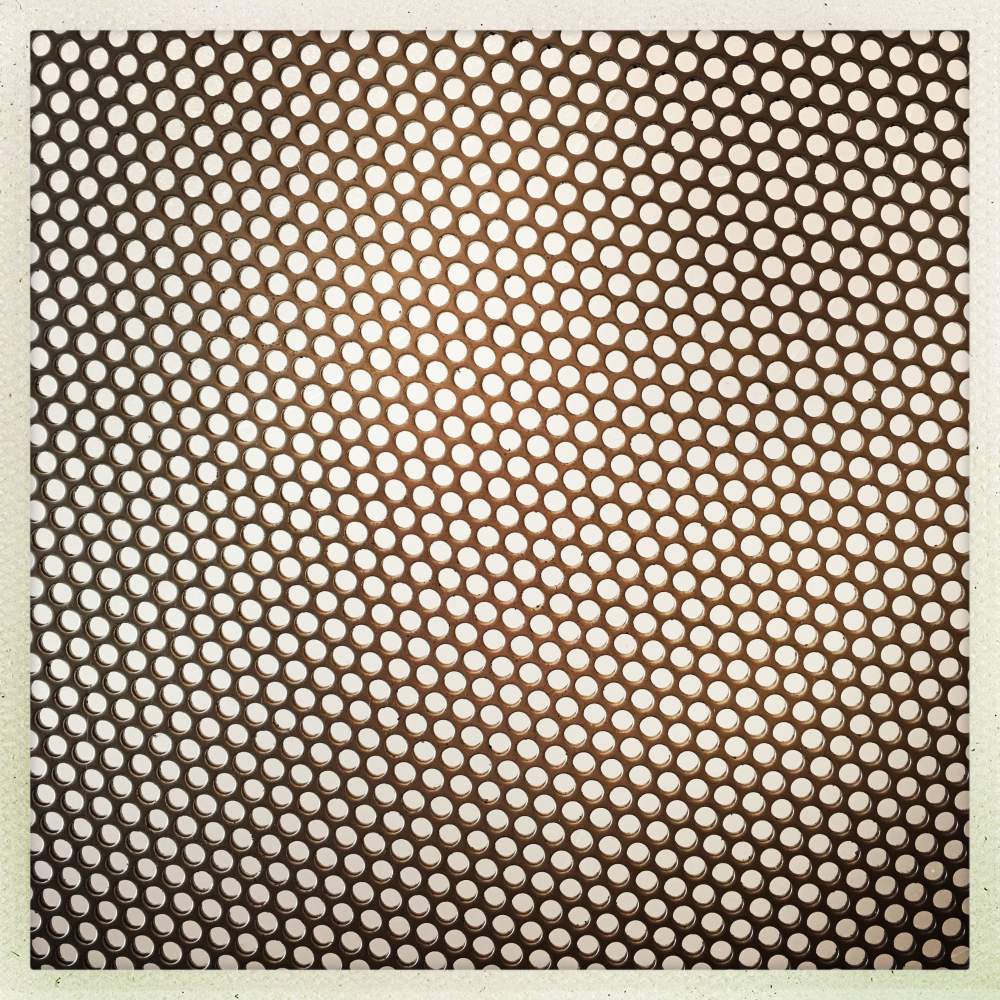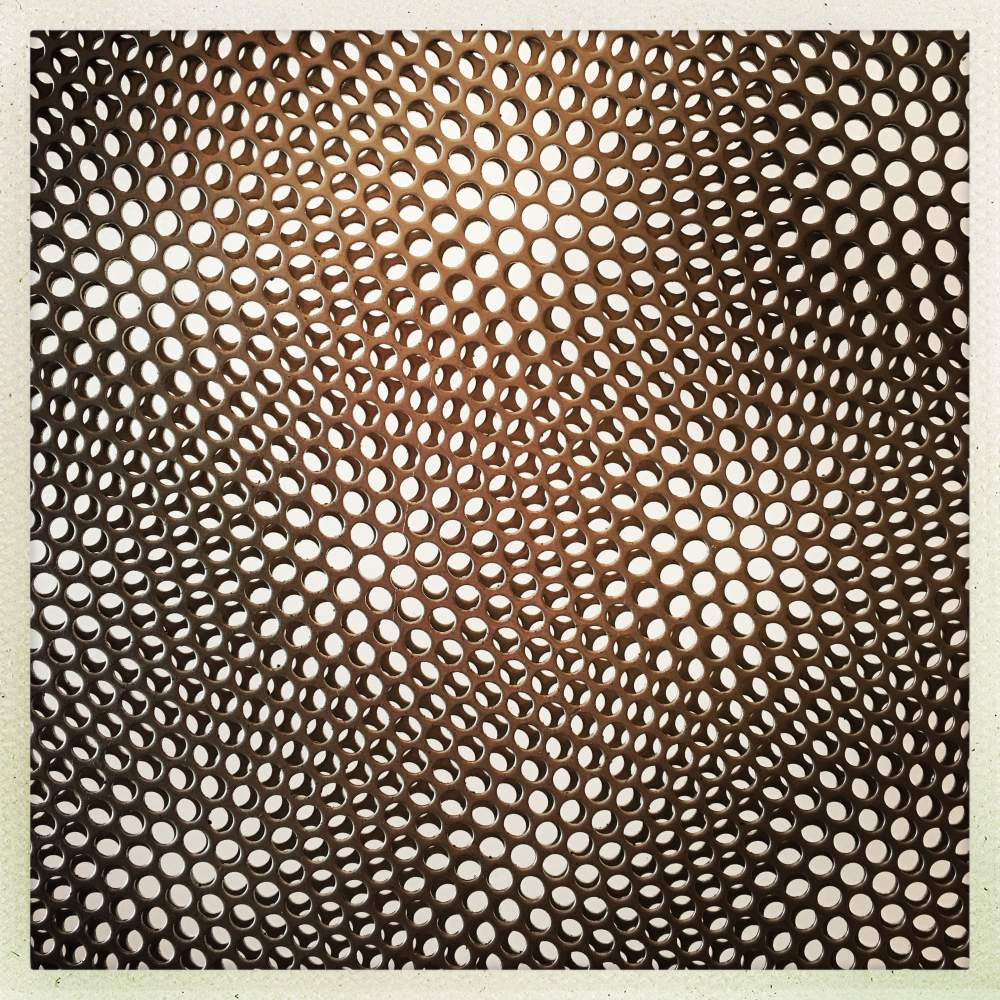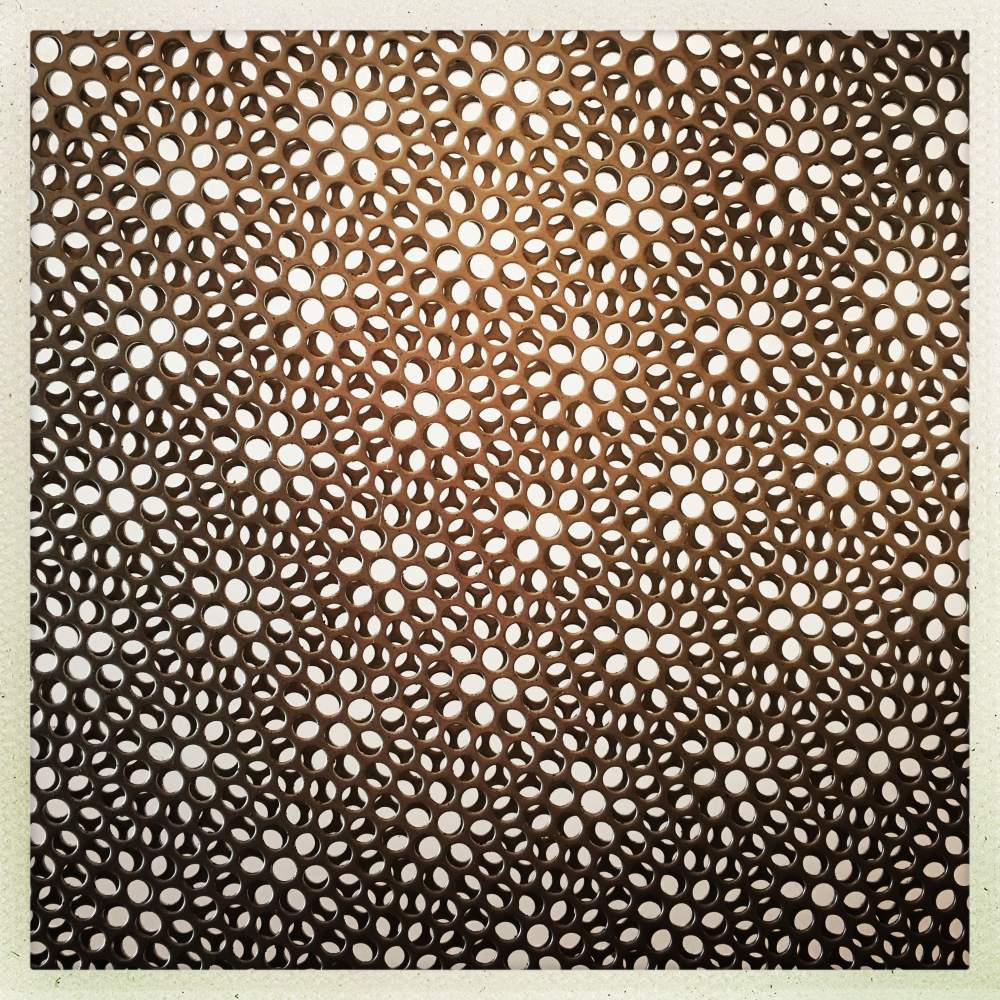A couple of sheets of 304 stainless steel, perforated, dropped into my mail box this morning. I’m hoping to eventually experiment with bonding it to high carbon steel, but that’s another story. When I unwrapped them, I noticed something weird – I thought maybe I had slipped something in my water without thinking about it, because what I saw reminded me of things I’ve seen while on painkillers or psychoactives.

Two sheets, equal alike in splendour, in Fair Verona where we set our scene…




When the sheets are in motion against eachother the patterns appear and vanish disconcertingly.
To do this properly I should have suspended the sheets with better lighting, but all I had was my shop lights and my iPhone. So, I whacked on it a bit in post-work. [Excuse the 80s porno-style theme music. I had to have something and techno/house would have been too much for me]

Moire patterns are always cool!
I thought at first that pattern of light and dark in the first picture was the metal, but I am guessing it’s your lighting.
Link related: https://xkcd.com/1814/
@James Matta, #1: re, your link: NICE. :-D
Back when I worked in graphics I used to have endless fun doing this with the sheets of dots that one used to use to get a black and white photo to print with halftones. I remember sending in an article that used moire patterns for the graphics to enhance the story, and the idiot printer “fixed” it without telling me and the article just really fell flat. head/desk
James Matta@#1:
“That’s a Moire” … ha! I love it. It’s better than a Moray.
Yes, it’s just my lighting. I dropped them down on my cutting table and didn’t worry about the light.
kestrel@#2:
Back when I worked in graphics I used to have endless fun doing this with the sheets of dots that one used to use to get a black and white photo to print with halftones.
Now I am going to start looking for the paisley in halftone dots, again.
Needs some chill house music.
Got to be some interesting mathematics in the way the patterns shift as the sheets are shifted and rotated. The symmetry keeps changing.
Martin Gardner would have had a ball with that.
(Oh come on, at least film in landscape mode!)
Cool stuff this moire business. Notice how the symmetries of the interference pattern is a scaled-up version of the symmetries of the underlying grids.
@Marcus Ranum #3:
When you’re swimming in the sea and a fish bites your knee, that’s a moray!
When an eel bites your hand with a pain you can’t stand, that’s a moray!
Reading the Callahan Chronicles by Spider Robinson primed me a million of these.
Ketil Tveiten@#7:
Oh come on, at least film in landscape mode!
Arrgh, I guess I could have rotated it with ffmpeg before I loaded it into videostudio. Durr…
I wonder if it’s worth trying to do a version of this that isn’t sloppy and half-arsed.
Notice how the symmetries of the interference pattern is a scaled-up version of the symmetries of the underlying grids.
I guess it would have to be, wouldn’t it? How much of what is going on is our brain’s pattern-detectors going wonky, and how much of it is geometry? I do not understand at all what is going on.
James Matta@#8:
Reading the Callahan Chronicles by Spider Robinson primed me a million of these.
Oh, right, that’s where that was from! Thank you!
I had a holiday recently where the kitchen and adjoining shower room had flooring of off-set black and red quarry tiles. The tiling was well done, but if you looked along it looked as if the rows were converging. The human pattern making ability does indeed do weird things.
jazzlet@#11:
The tiling was well done, but if you looked along it looked as if the rows were converging.
Have you ever crossed your eyes at a tile floor and had your brain’s 3D interpretation engine go wonky? That’s tons of fun – there was one time I closed my eyes on the toilet, then opened them (my parents’ bathroom has black/white subway style tile floor) and I guess they were slightly crossed and there were tiles floating in the air and tiles below the floor. And I wasn’t high or drunk. I have noticed, though, that tequila can produce that effect – I assume it’s just messing up your eyes’ ability to track.
Maybe. There are stranger things on youtube. I think that with proper lightning and music this could produce an entertaining short kaleidoscope-vid.
X-Rays and atomlattices, small particles under a microscope, holes in steelplates, the emergence of patterns always fascinates me. Two lattices nearly, but just not exactly lining up, mix in the human brains ability to see patterns whrere there are none.
Most beautiful!
Ooooooooooooh, beautiful!
bow chika wow wow
The really interesting things happen when the patterns have slightly different sizes (“wavelengths”), in this case if you had two perforated sheets with slightly different gaps. What you get is another pattern with a much larger repeating length.
I’m actually using an optical measuring system based on this at the moment: Several patterns with wavelengths on the order of a few pixels (~3 mm) are displayed and combined to produce patterns roughly half a meter long. It’s a way to measure – in theory – large distances with a precision in the micrometer range.* Sadly it’s not much to. All you get to see is a sequence of stripes and only the computer gets to see the real patterns as it combines all the different camera images. And it would one-dimensional anyway, since the pattern only has one direction.
I’m sure if you tried it with different perforated sheets Interesting Things would result. Since you are in the process of setting up your own workshop you could also experiment with different geometries or hole shapes. Just in case you ever get bored. Maybe you could even build a mesmerising workbench or shelf. Bad Ideas seem to sell so you could probably make a fortune marketing workbenches too distracting to work on. It would make a great gift for procrastinators.
*There’s theory and practice. And worlds in between.
Reminds me of a time I was tripping in a motel and spent hours looking at the wallpaper in the bathroom.